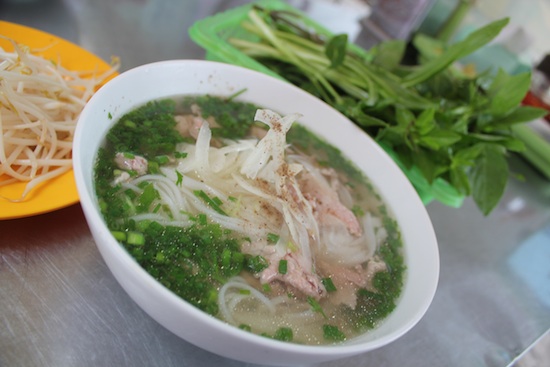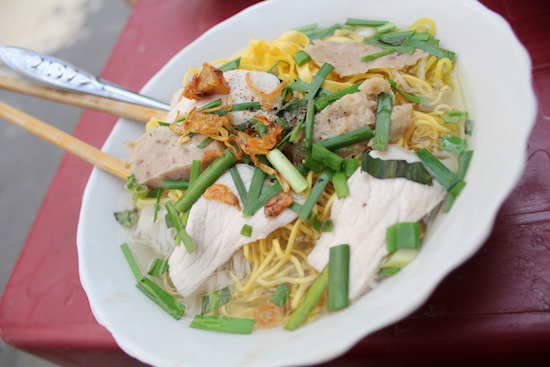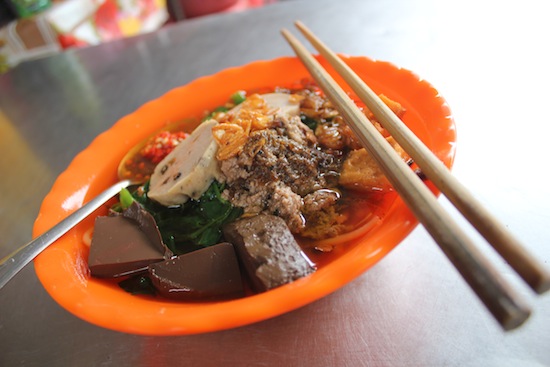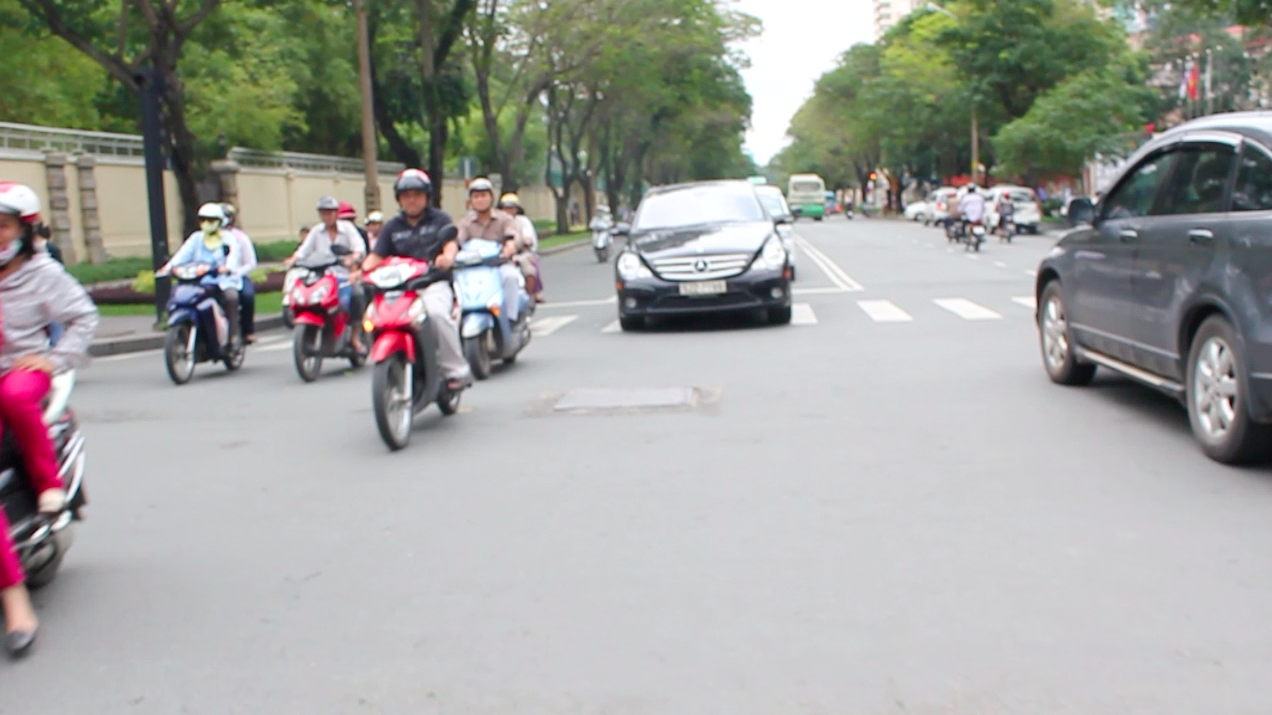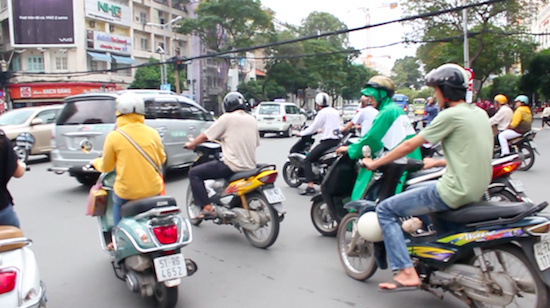Also popular – all over Vietnam – is the acrylic pajama suit, usually in bright colorful combinations or with geometric patterns. They seem to be the standard dress for middle aged married women. Marry a Vietnamese woman and this is what you'll have to look forward to, your wife rolling out of bed and immediately ready to head to work or run errands. On the flip side you'll never hear her say "I have nothing to wear!"
Sunday, September 30, 2012
Imagine never having to get out of your PJs...
Also popular – all over Vietnam – is the acrylic pajama suit, usually in bright colorful combinations or with geometric patterns. They seem to be the standard dress for middle aged married women. Marry a Vietnamese woman and this is what you'll have to look forward to, your wife rolling out of bed and immediately ready to head to work or run errands. On the flip side you'll never hear her say "I have nothing to wear!"
Mid Autumn Festival -Video
Paul and I will have our fair share of moon cakes while drinking whiskey in our hotel room because all of the festivities are so far away, of course the traditional drink is tea. Luckily, there was an event right across the street from our hotel. We had such a great time and I can't wait for the Tet celebration which is a larger holiday in February. Below is a video from online because I accidentally deleted mine but was able to salvage the photos.
http://www.youtube.com/watch?v=kLh4oZzS0yk&feature=player_embedded
drummers...this group of performers were made up of 12-18 year old boys
i need better flash but this was amazing in person
check this guy out he was amazing on top of this pole!
http://www.youtube.com/watch?v=kLh4oZzS0yk&feature=player_embedded
drummers...this group of performers were made up of 12-18 year old boys
i need better flash but this was amazing in person
check this guy out he was amazing on top of this pole!
Saturday, September 29, 2012
What not to do while you're in Vietnam
While travelling in Vietnam, harsh as they seem, local laws apply to all. The penalties for actions which you might find over the top are taken very seriously by locals.
Try to remember this is a conservative, communist country where the excesses of western culture are not tolerated.
Mind your p's and q's and you'll have a trouble-free enjoyable visit.
Strict Drug Laws, Strong Drugs
Penalties for drug offences are severe. Under the Vietnamese penal code, a person caught in possession of even a small amount of heroin can be sentenced to death.
There are over two dozen foreigners currently serving life sentences or facing the death penalty for drug trafficking offences. Vietnamese authorities have announced increased security and investigative measures to combat drug trafficking.

When good advice is ignored, travellers should be aware that recreational drugs available in Vietnam can be extremely potent. Party with caution, and always make sure someone knows where you are and what you have taken.
Sensitive Photography
Photography of border crossings and military installations is prohibited and may result in arrest. You should also avoid taking photographs during demonstrations. Leave the military shots to the journo’s, as the glare of a Vietnamese soldier is incredibly intimidating.
Sensitive Borders
You could be detained if you venture too close to the border with China, Cambodia or Laos without prior written permission from the local authorities.

Antiquities
It is against the law to export antiques from Vietnam without a permit. The Ministry of Culture can provide further advice and any necessary permit.
Gambling
Gambling, except in government licensed casinos, is illegal in Vietnam. Anyone found to be in violation of this law is subject to steep fines and/or a severe prison sentence. Access to licensed casinos is restricted to holders of foreign passports.
No Politics
Anyone, Vietnamese or visiting foreigners, engaging in public actions that the Government determines to be political in nature could be arrested and detained. Even your private conversations can lead to legal actions.
No Religion
U.S. citizens who sat they've come to be tourists, but then engage in religious proselytizing have had religious materials confiscated and have been expelled from Vietnam. Sponsors of small, informal religious gatherings, such as Bible-study groups in hotel rooms, have been detained, fined, and expelled, although these outcomes have become less common because of improvements to religious freedom.

No Blogging (I'm just focusing on the cultural nuances, hope that's not a crime)
Blogging about the Vietnamese government and discussions in on-line chat rooms have also incurred scrutiny from authorities. The distribution of anti-Vietnamese propaganda is considered to be a terrorist offense by Vietnamese authorities. In most cases individuals are detained, questioned, and then released. In the past year, at least ten U.S. citizens were arrested, prevented from leaving Vietnam, and/or deported.
Tuesday, September 25, 2012
Taxis
Taxis in Saigon are easy to find and cheap to ride, but they can be a trap for the unknowing tourist. Here are a few tricks of the trade for you to know about theSaigon taxi business.
Choosing the right taxi company is very important and will save you money. I stick to Vinasun and Mailinh, who are the more reputable companies in town, because they have more reliable meters and drivers. Other taxi services have meters that jump in price wildly, or have no meters at all, and drivers that may try to take you to a different location.
Most of these off-brand taxis hang out at tourist hotspots such as the War Remnants Museum or the airport, preying on the unsuspecting visitor. If you find yourself in this kind of situation, walk to the end of the block where you may be able to find a better taxi. Some taxi services have even gone so far as to mimic one of the more respected brands with their logo. If I hail a taxi and another company’s cab tries to pick me up I will wave them off -- don’t worry, they’re used to it.
Once you’re in a cab, be sure to have a copy of your destination’s address written down to ensure minimal confusion for you and the driver. If you are asking to be taken to a place you know to be a popular destination and your taxi driver seems confused, do not feel the need to stay in the cab. I have been in quite a few taxis where the taxi driver either didn’t know my destination, or pretended not to know, and took me for an expensive ride.
Another thing to watch out for is cab drivers making unnecessary stops such as checking tire pressure, getting gas, or even relieving themselves on the side of the road (seriously, this happened to me). Always remind your cab driver to turn off the meter if you make an unscheduled stop. It is your duty to watch the meter; no one else will do this for you.
Once you get to your final stop remember that in Vietnam, unlike many other countries, it is not customary to tip the driver. Tips will however be accepted and I usually leave the small change with the driver. Before you get out make sure you have all of your belongings, as a phone left in a cab will likely be a phone that is never seen again.
Mooncake Festival
The Mooncake Festival is held in Vietnam on 9/30/12
- info from Wikipedia
The Mid-Autumn festival is named "Tết Trung Thu" in Vietnamese. [10]
The Vietnamese version of the holiday recounts the legend of Cuội, whose wife accidentally urinated on a sacred banyan tree. Soon after desecrating the tree, Cuội sat on one of the tree branches and the sacred tree began to grow and continued until it finally reached the moon, leaving him stranded there. Every year, during the Mid-Autumn Festival, children light lanterns and participate in a procession to show Cuội the way back to Earth.[11]
In Vietnam, Mooncakes are typically square rather than round, though round ones do exist. Besides the indigenous tale of the banyan tree, other legends are widely told including the story of the Moon Lady, and the story of the carp who wanted to become a dragon.[11]
One important event before and during the Vietnamese Mid-Autumn Festival are lion dances. Dances are performed by both non-professional children's groups and trained professional groups. Lion dance groups perform on the streets, going to houses asking for permission to perform for them. If the host consents, the "lion" will come in and start dancing as a blessing of luck and fortune for the home. In return, the host gives luck money to show their gratitude.
[edit]Dates
The Mid-Autumn Festival is held on the 15th day of the eighth month in the Chinese calendar, which is in September or early October in the Gregorian calendar. In 2012 the Mid-Autumn Festival will fall on September 30th. It will occur on these days in coming years:[12]
- 2012: September 30
- 2013: September 19
Monday, September 24, 2012
Healthy Traveler
So since I'm totally a local now.....I found some helpful tips for travelers borrowed from "world nomads"


Get Your Shots!

Just 25 years ago Vietnam was cripplingly poor and with a dreadful economy where inflation ran at 700%, food (and everything else) was rationed and distributed from government warehouses.
Things have improved vastly, the economy is booming and daily ife is much better, but this is still a relatively poor country. The average per capita income is $1200 a year. It is rugged, mountainous and tropical so infrastructure for the 90 million citizens is still third world. This is part of the charm of travel to Vietnam, but there are consequences for the traveller, especially in regard to health.
Here are a few tips to keep you travelling safely.

Mosquitoes and Disease
The mosquito-borne illnesses malaria and dengue fever are prevalent in Vietnam, particularly in the south. There has been an increase in the number of cases reported and deaths from dengue fever. In 2010 there were 109,304 dengue cases, including 84 deaths! From the recent 11 mosquito bites I got, they have not been accompanied by a fever so I think I should be fine.
Mosquitoes carrying Malaria and Dengue fever love the wet climate, so be careful when trekking in places like Sapa. Wear long trousers and socks, and lather insect repellant on your skin like its going out of fashion!
Keep in mind it is advised not to take Aspirin or Ibuprofen until Dengue fever has been ruled out.
Food, water & Hygiene
Food glorious food! One of the highlights for travellers visiting Vietnam is sampling the local delights. Keep in mind that hygiene standards in restaurants vary. If it looks like it may make you sick, it probably will.

(A perfectly healthy and clean meal of grubs!)
In June 2010, there were reports of approximately 100 tourists (who ate at different restaurants) hospitalised with food poisoning in Binh Thuan province.
Outbreaks of water-borne, food-borne, parasitic and other infectious diseases occur from time to time in Vietnam. Try avoiding salads or anything directly washed with water and not cooked. If you do suffer form a severe diarrhoea outbreak then visit a local hospital.
Water cannot be consumed from the public water system in Vietnam, so stick to bottled water which has been sealed correctly. A well-named safe brand is La vie - Vittel France.
Get Your Shots!
The World Health Organization (WHO) recommends the following vaccinations for travellers to Vietnam:
• Adult diphtheria and tetanus
• Hepatitis A & B. Hep B should now be the norm for all travellers. It is given as three shots over 6 months so be sure to plan ahead. It offers lifetime protection for 95% of people.
• Measles, mumps and rubella
• Polio
• Typhoid
For more information, every traveller should visit their doctor or travel doctor prior to travel. The Pasadena Healthy Traveler also recommended Japanese Encephalitis and Rabies
Sunshine Safety
Vietnam has some beautiful weather. It is located in the tropical zone characterized by sunshine, high rainfall, humidity and monsoon.
The average temperature is from 22ºC to 27ºC with two distinguished seasons in the South: the cold and dry one from November to April and the other hot and wet from May to October. The North has four distinct seasons: Spring, Summer, Autumn and Winter.

Flooding is common in and around Hanoi, in Northern Vietnam and in the Mekong River Delta regions in the south from June - December, but that isn’t something to plan a trip around as its half the year!
The best time to visit the country is from October to April, but pack light, easy-to-dry clothing as it can go from buckets to sunshine within minutes.
Street Vendors-Soups
Saigon has no shortage of street food but the city’s selections of soups are where you will find some particularly impressive dishes. Here are a few soups that you should give a try while trawling the streets of the city.
The most famous of Saigon’s street soups is easily pho, and the vendors on the city’s streets have turned their craft into a fine art. Pho seems simple enough; made with flat rice noodles, some meat and a healthy helping of greens thrown in however, it turns out it is anything but. Most vendors start preparing their stock the day before it will be served, each concocting a slightly different version of the soup. Going to different pho kitchens can lead you to experience completely different soups; some are sweeter, some heartier. Usually, you will have a few choices of meat, ranging from thinly sliced beef to meatballs, but at larger pho restaurants you can have dozens of options. Pho isn’t at all hard to find and, while street carts do sell it, the best pho spots are typically the more permanent, established locations. Expect a bowl on the street to cost around 20,000 to 30,000 VND.
Although it has a different Vietnamese town in its name, some say the best bun bo hue is found in Saigon. Bun bo hue is a more straightforward soup than pho, with fewer options when it comes to meats and extras. It starts with a pork or beef broth spiked with lemongrass then combined with noodles and sliced beef. A traditionally spicier soup, bun bo hue is usually topped off with Chinese sausage, some greens and a plate of bean sprouts. Its round, spaghetti-like noodles can become slippery for even masters of the art of chopstickery when combined with the broth -- losing a big bite can cause a bit of slash back during your meal. Avoid wearing white! A very popular soup, its simplicity makes it one of the more common carts you’ll see on the street -- don’t expect carts to be huge in size or to have a huge variety of ingredients on display. A bowl usually runs 20,000 to 30,000 VND.
While other soups in Saigon have some options when it comes to what you put into them, generally at least some things, like the noodles, are a constant. Hu tieu is a must-try because there are simply so many varieties. The basic dish consists of a light pork broth with slices of pork, Chinese sausage, bean sprouts, green onion and a healthy dose of thin white rice noodles but as you get more comfortable with the dish you can get more creative. Don’t like the noodles? You can try thin or thick, yellow egg noodles or a brick of ramen. Want different meat? You can add shrimp, quail eggs or small wontons. You can order your broth on the side and prepare the soup in your own special way. This is a popular soup and easily found on most of the city’s streets; you can usually spot it as one of the only street carts with multiple noodles on display. Hu tieu is also cheap, with bowls as low as 10,000 VND and rarely over 20,000 VND.
If you’re really itching to try something new, is one of the more unique soupsyou’ll find on the streets of Saigon. It's a brightly coloured dish, usually made with vibrant orange rice noodles much thicker than what you’ll find in other soups, and topped off with freshly blanched morning glory. The colour isn’t however what makes canh bun stand out -- it's the minced crab added to the bowl, which looks like a ground pork or beef. Topped off with tofu, Chinese sausage, cubes of congealed blood and a healthy dose of chilli paste, a bowl of canh bun is quite a meal. Findingcanh bun is a little harder than some of the more famous soups, as you rarely see it sold on its own; your best bet is to head to a market and find a stall. Expect a bowl to cost 20,000 to 35,000 VND.
On the streets of Saigon you won’t have to look far to find someone selling food from a cart. From noodle dishes to sandwiches, you can find almost anything but you may find that soups dominate the landscape of HCMC’s street food. This might not be much of a surprise since pho is the most well known Vietnamese dish but there are seriously a ton of soups on the street. Most are noodle based but one soup has no noodles whatsoever and is a staple of local cuisine: the ever-popular soup called chao.
Called congee in the Western world, chao is basically a type of rice porridge; rice is cooked in a large pot of water until it softens into a creamy soup. Usually, you’ll seechao coupled with a meat, which is cooked with the rice in the pot. The most popular versions are chao long, porridge with pork entrails and congealed blood, andchao ga, porridge with chicken and ginger. Luckily in Saigon, because of its close proximity to the water, you can also find a few seafood varieties of the soup; including chao ca, porridge with fish, or chao muc, porridge with squid.
Since the meat is usually cooked with the porridge a street cart seldom has more than one version of chao. This means a market that has street food stalls could have a few chao stalls all selling a different version of the soup. Ordering a bowl is pretty straightforward as most of the dish is already prepared in the pot however you will have the option of adding bean sprouts, chillies and chunks of fried bread. Chao is popular throughout the country as a breakfast food, however it can be eaten all day. Many locals consider chao to be a cure for the common cold, like their version of chicken soup.
Since one cart will only have a single version of chao they tend to be some of the better marked street foods in the city. If you see an unmarked cart a few indications that it sells chao will be the large pot, an absence of displayed meats, and a stack of fried break sticks. You’ll be able to find it almost anywhere in the city: mobile carts selling chao ga or chao long are regular sights, but if you’re looking for a seafood flavour head to a market or another area where street food congregates.
Chao is an inexpensive dish even by Saigon street food standards. A bowl is usually around the 10,000 VND mark and even seafood versions rarely run more than 20,000 VND. Plus, since the soup is on the thicker side, it is maybe a little more filling than the other soups on the street. Give chao a try and see what you’ve been missing; you don’t even have to be sick to enjoy it.
Traffic Law-Enforced?
I wanted to touch on the traffic laws out here but found a blog that layed it out perfectly so here it is. I was actually looking for traffic rules and apparently there aren't any documented on the government's website, yet traffic laws do exist but they don't provide it in any forms. Like I said before, it's very backwards here! The video below is awesome, it shows you how to make a left, probably the hardest thing to do on the road here.
Traffic in HCMC is ridiculous: it’s noisy, congested and totally awesome to watch. If you utube Vietnam Traffic, from the outside it would most certainly seem chaotic; people driving on the sidewalk, almost no regard for traffic lights, people swerving around people at whatever speed they desire. It’s so crazy that most people would be surprised to learn there are actually traffic laws that are actually enforced.
For years Western visitors to Saigon, and the rest of the country for the matter, have enjoyed an even further escape from the lightly enforced laws of the road; the few police on the street have been reluctant to pull foreigners over. But the times, they are a-changing. There are now more police on the road than ever and more who speak English. So if you decide to join the madness and ride, like Paul and I have decided to do, here are some tips if you are unlucky enough to be stopped by the iron hand of the law.
First, know what you can be pulled over for. The fewer rules you break, the less likely you will be harassed. Some things are obvious: not wearing a helmet will get you stopped, speeding is against the rules and riding with more than two people will get an officer’s attention.
Some traffic laws are lesser known: the left lane is reserved for cars, so if you enter it with a bike you can be stopped; excessive honking is actually against the rules; and having your headlights on during the day is a stoppable offense. Also, remember the fact that if you don’t have a Vietnamese drivers' license then you are also breaking the law; your international permit is effectively worthless in the country. Sometimes police officers will just pull you over for being a Westerner, banking on the 99% chance that you won’t have the proper documentation.
If you do get stopped -- usually by an officer who will walk into the middle of the street and point at you -- remember to play it cool, follow directions and try to stay positive.
Most of the time this is how it goes down. The police here are notorious for using Western tourists to line their own pockets; generally after they stop you and inform you of your infraction they may simply write an amount on a piece of paper and demand that you pay it in cash on the spot. In my experience this number has been 500,000 VND, which compared to a fine in the Western world is pretty low.
This number is negotiable. I learned this the first time I got pulled over, when the officer wrote 500,000 VND on the ticket but I only had 200,000 VND in my wallet. I showed him the situation, he took the bill, and I drove away. The second time I was stopped, he wrote 500,000 VND, I simply gave him 200,000 VND, and he let me go. My tip is to not drive with 500,000 VND bills in my easily accessible wallet. Keep your big bills somewhere else, like in your backpack or your motorbike seat, and drive with smaller stuff. An officer will usually always accept 200,000 VND. If they insist on more you can either give it to them or have your bike confiscated for a month, which will be quite the hassle.
If you get pulled over, pay the fine and move on with life; it’s not a crazy amount of money -- and besides, it's quite likely that you probably were breaking the law.
Turning left, where you have to cross the oncoming lane of traffic, is something that some people struggle grasping in their minds. It can seem inconceivable, as there are few turn signals in the city, mostly because it requires you merge from the right side motorbike lane to past the left side car/bus lane and then venture into oncoming traffic. Although it can seem scary, and a little dangerous, once you get over the mental hurdle, you’ll find that turning left is easy and kind of fun.
The first thing to remember is that turning left is similar to crossing the street. To cross the street in Saigon, you simply step into the road and most drivers will stop or swerve around you; this is similar to turning left, when if you advance at a slow and steady pace, the oncoming traffic will break around you also. Just remember that HCMC streets are less guided by actual traffic laws and more by the laws of nature; if something is bigger than you it may not want to stop. By this I mean that while most motorbikes and taxis will tend to avoid you, you should be careful before you cross paths with a city bus.
It can still be nerve racking, even for the seasoned driving vets, to jump into oncoming traffic, so there are ways to make things a little safer. A common tactic is to use a traffic blocker. This can be done in a couple of ways. Firstly, you can join a pack of motorbikes turning left together. By doing this all the motorbikes work together to make themselves a bigger object when crossing. Another way to turn is to partner with a turning car. Since more things will stop for a car than for a bike, you can simply wheel yourself up next to the driver’s side of the car and use it as a shield to deflect the traffic.
Again, at first this can seem crazy and it can take some time to get used to. I have a friend who initially refused to make left turns and instead would make three rights. The best thing to do is to keep your speed down and take things nice and slow;once you get the hang of it you may find driving in Saigon to be a little addicting...apparently people in San Gabriel Valley still drive like this.
Sunday, September 23, 2012
"The Vietnamese Squat"
I think she was the inventor of the squat, see how natural it is. it's funny that when they are not squatting, they have the smallest plastic chairs to compensate.
these are the higher chairs, maybe one day it will reach the same height as western chairs
in the middle, the little red chair is the size they typically sit on
this is how most restaurant set up their dining area. i guess they are beginning to accommodate the expats with the regular size chairs, but it feels really awkward since the table is so low
the squat can be used in many different occasions, it is used most often when cooking...
this move can also be used during work breaks or even while you're waiting for the bus or even a cig break...
my favorite is the huddle, I believe they're conducting a business meeting, so much for conference rooms!
Malaria!
I hope I don't get some disease like Malaria! I got bit 11 times yesterday by these tiny mosquitos. Apparently they only like my blood or I tend to emit more heat making me a more desirable host. Paul walked through high grass and I stayed back on the road, yet I was the one who was attacked. So much for wearing shorts or dresses anymore. I'm gonna have to tough it out and wear jeans now. I am currently using Off a brand in the states and it seems to work but you must apply every time 2-3 hours.
These are mosquito zapper rackets and it basically uses electricity to kill them, a must have in your home and office.
 when we move, i'll have to buy one of these bed nets so i won't have to worry about getting eaten alive while im sleeping. we don't have a problem in our hotel now, and i hope we won't at our new home either.
when we move, i'll have to buy one of these bed nets so i won't have to worry about getting eaten alive while im sleeping. we don't have a problem in our hotel now, and i hope we won't at our new home either.
check out each bite on my leg, they began to welt, each bite began to burn and itch immediately. once the venom entered my body, it felt like bee stings.
i went to a vietnamese pharmacy right away and bought 2 different types of mosquito medicine. the one on the right offers more relief then the left. it's only day 2 and it still itches like crazy and i think it's gonna scar :(
Subscribe to:
Posts (Atom)


















